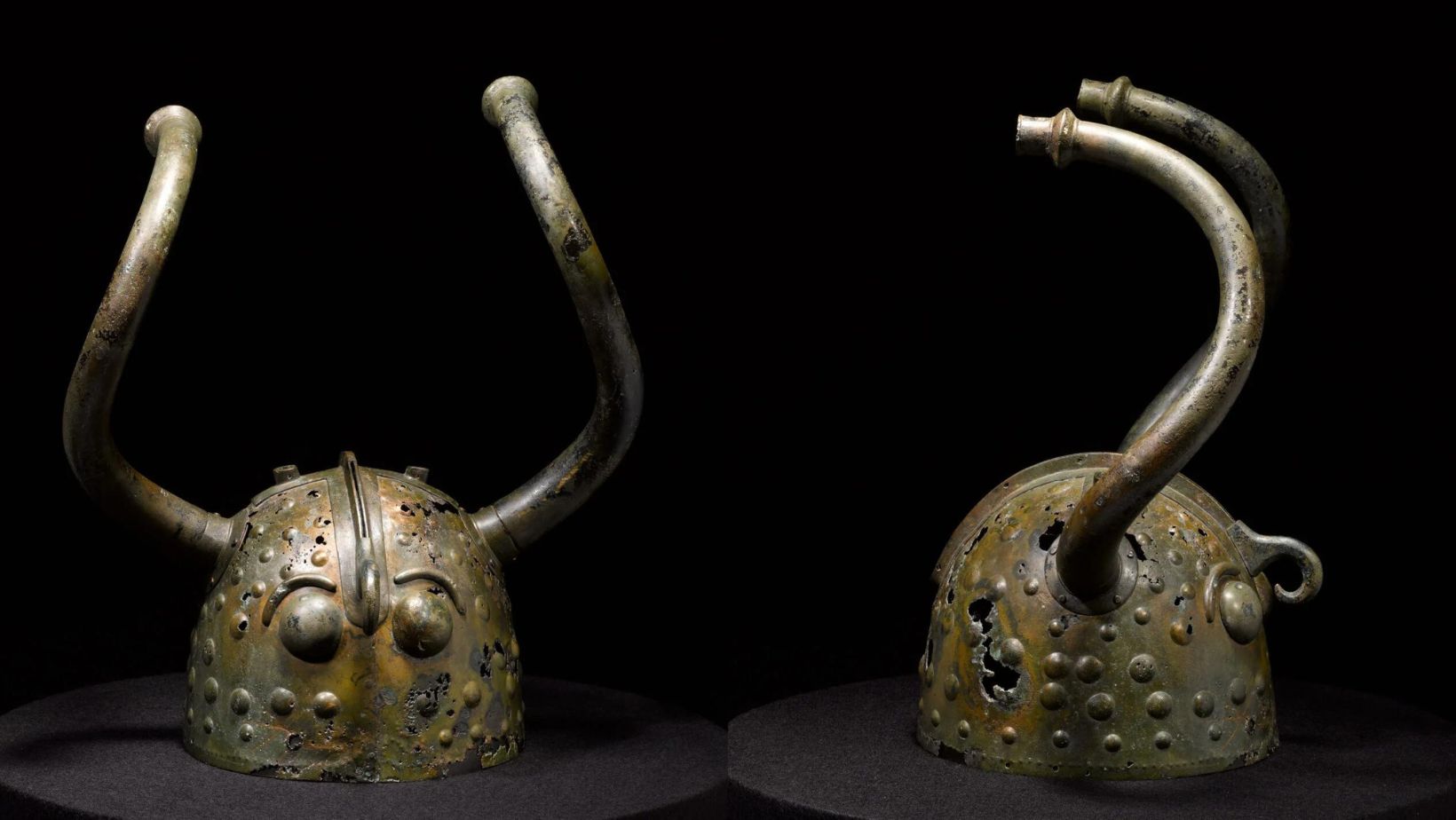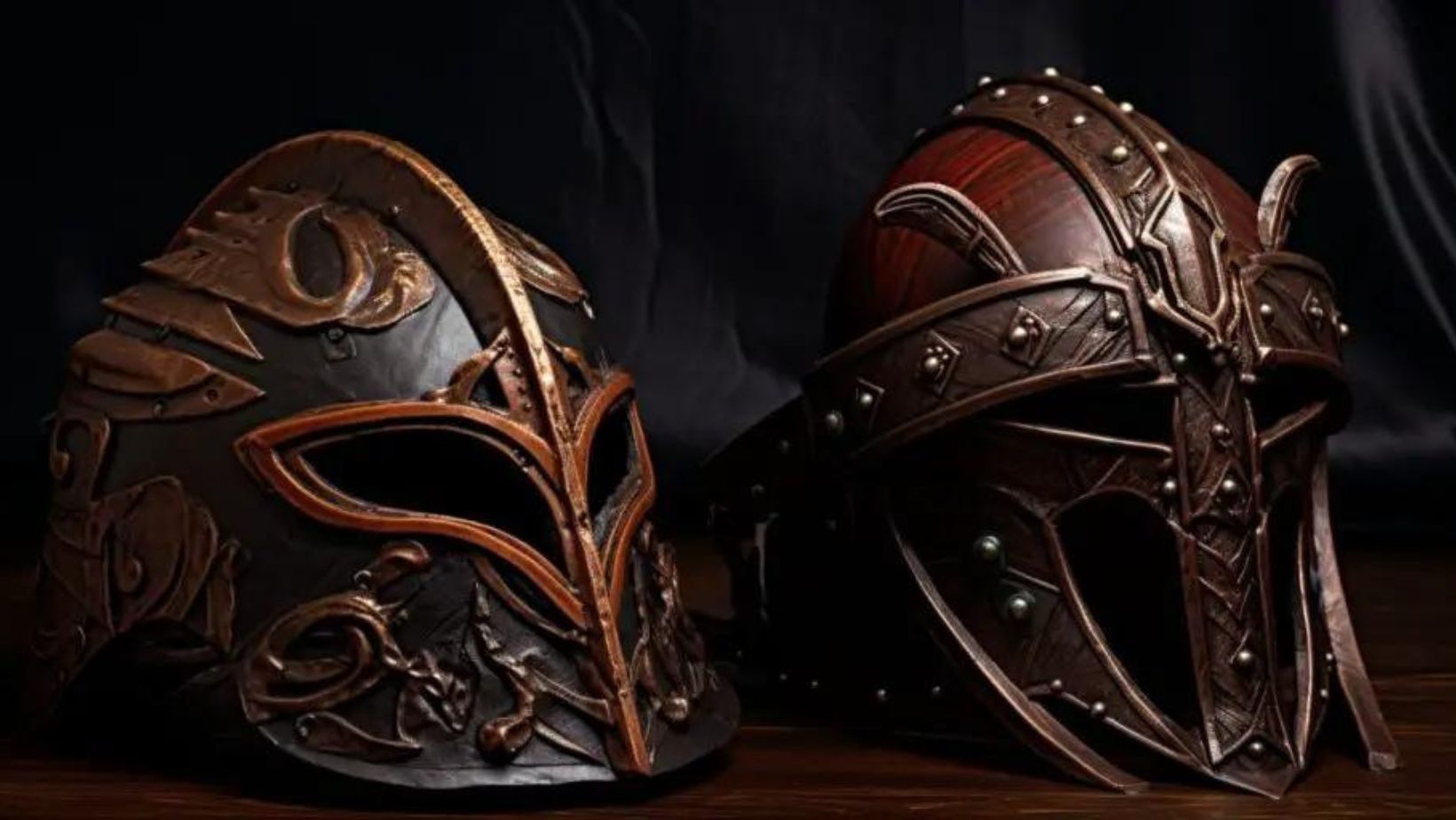So, why did Vikings wear horned helmets? Spoiler alert: they didn’t. The iconic image of a fierce Viking warrior decked out with horns protruding from his helmet is nothing more than a historical hiccup, a blend of creative liberties and misunderstood artifacts.
By diving into this post, you’ll unravel the truth behind those mythical horned helmets and answer why did Vikings wore horned helmets. You’ll discover how Wagner’s operas and 19th-century art got us all believing in something that never was—a classic case of fiction trumping fact.
We will strip away centuries of misconceptions and reveal what Vikings wore into battle. Their headgear had its own story—one rooted deeply in history rather than on stage or canvas.
Let’s find out why did Vikings wear horned helmets!
Table Of Contents:
- The Myth and Reality of Viking Horned Helmets
- Unearthing the Truth About Viking Age Helmets
- Artistic Depictions vs. Historical Evidence
- FAQs in Relation to Why Did Vikings Wear Horned Helmets
- Conclusion: Why Did Vikings Wear Horned Helmets?
The Myth and Reality of Viking Horned Helmets
Pop culture has long paraded the image of fierce Vikings donning horned helmets into battle. But hold your horses—history tells a different tale. Despite what many believe, no evidence points to real-life Vikings wearing these iconic accessories in combat or any other occasion.
Wagner’s Influence on the Horned Helmet Image
Rumor has it that Richard Wagner is the big cheese behind this headgear hoax. When his opera cycle Der Ring des Nibelungen, inspired by Germanic mythology, hit the stage in the late 19th century, costume designer Carl Emil Doepler decked out actors with horn-tipped hats for dramatic effect. This artistic choice struck a chord with audiences and set an enduring trend.
In truth, while horns did grace some Bronze Age helmets discovered across Southern Europe and Eastern Mediterranean regions, they were not from the Viking era nor linked to Scandinavia’s Norse warriors. Instead of gearing up like bull-headed beasts, historical digs reveal that authentic Viking-era helmet fragments lack such flair—no protruding spikes or animal motifs graced their war gear.
Scandinavian Artists and Cultural Misconceptions
Digging deeper into our trove of tall tales brings us face-to-face with Scandinavian artists who further chiseled this myth into history’s stone tablet. Gustav Malmström included illustrations featuring Vikings rocking pointy lids as part of Swedish national romanticism—an art movement driven more by creative freedom than historical accuracy—and people just ate it up.
Cultural misconceptions are tough nuts to crack once they take root, yet despite countless reiterations in movies and Halloween costumes over time—the fact remains: No archaeological dig site from Iceland’s shores to Denmark’s depths ever coughed up proof that Vikings wore horned helmets during their heyday around A.D 800-1050.
Radiocarbon Dating and Its Revelations
You might wonder how we can be so sure about what went down centuries ago without Instagram posts as receipts. Well, folks, radiocarbon dating comes to our rescue here. This scientific method helped researchers pinpoint when those few genuine Nordic noggin protectors were made—it turns out none date back close enough to even remotely overlap with our boat-loving berserkers’ timeline. History.com.
So why does everyone think Vikings sported such wild headwear? It seems likely because political regimes used strong images connected to their warriors. But it turns out this iconic image is more myth than historical fact. Archaeological evidence doesn’t back up the horned helmet idea; no authentic Viking helmet with horns has ever been discovered. The misconception might come from a few 19th-century artists who depicted Vikings in dramatic flair for operas and artwork—so that’s what stuck in people’s minds.
Key Takeaway: Why Did Vikings Wear Horned Helmets?
Why Did Vikings Wear Horned Helmets? Despite popular belief, Vikings never wore horned helmets; this myth was fueled by 19th-century art and opera for dramatic effect. Actual Viking helmets were practical, without horns or animal motifs—just one of many cultural misconceptions history loves to hold on to.
Unearthing the Truth About Viking Age Helmets
A fierce warrior with a horned helmet often springs to mind when we think of Vikings. But history tells us another story—one without the iconic horns. Where did our concepts originate? Let’s peel back layers of myth and peek into what archaeology reveals about accurate Viking headgear.
Radiocarbon Dating and Its Revelations
The tale of the horned helmets begins in an era well before Vikings set sail: around 900 B.C., according to radiocarbon dating. This was during the Nordic Bronze Age, centuries before any recorded Viking raid. Researchers at Aarhus University have utilized this method to accurately date artifacts like the Viksø helmets, which sported not just horns but also eyes and beaks, resembling birds rather than anything you’d find on a battlefield during the Viking age.
Fragments remain regarding authentic Viking-era helmet finds—none feature horns. These pieces offer clues that actual battle gear was more about protection than grandiose display; they were functional above all else.
Let’s bust some myths: Horns would’ve been impractical for combatants clashing shields and swords; their presence could snag enemy weapons or make wearers easy targets—not precisely what you want when survival is online. Archaeologists have scoured ancient sites across Scandinavia hoping for evidence supporting popular culture’s depictions but found no such proof within these lands or along Atlantic coasts where Norse seafarers traveled far and wide.
Viking-Era Helmet Design Details Uncovered by Experts
Diving deeper into historical records shows us how costume designer Carl Emil Doepler may have played a part in crafting this false narrative with his imaginative designs for Richard Wagner’s opera cycle “Der Ring des Nibelungen.” The lavish productions needed something visually striking—and boy, he delivered. With horse hair plumes atop bronzed metal work designed as much for theatergoers’ awe as any semblance of accuracy regarding period armor styles—they captured imaginations then…and now.
Helle Vandkilde from Aarhus University sheds light on actual design elements used by warriors of yore through her work published in journals like Praehistorische Zeitschrift, highlighting details such as intricate metalwork reflecting religious beliefs or status among peers. She challenges the misconception that designs were based solely on aesthetic reasons, revealing a rich tapestry of cultural significance behind historical artifacts.
Key Takeaway: Why Did Vikings Wear Horned Helmets?
Why Did Vikings Wear Horned Helmets? Forget the horned helmets; accurate Viking headgear was about function over flair. Those iconic horns are more a product of theatrical imagination than historical fact, with zero evidence from ancient Scandinavian sites or seafaring routes to back up their existence in Viking times.
Artistic Depictions vs. Historical Evidence
Viking culture has captivated the imagination for centuries, often shrouded in myths and visual stereotypes that have been tough to shake. A fierce warrior sporting a horned helmet is one of the most persistent images. But does this image hold up when we pit artistic depictions against historical evidence?
Wagner’s Influence on the Horned Helmet Image
The opera cycle Der Ring des Nibelungen, by Richard Wagner, left an indelible mark on our collective consciousness about Vikings. While Wagner never set out to create a historical documentary, his work was visually interpreted through costume designs that included those infamous horned helmets.
This imagery became so popular that it transcended its operatic origins and found its way into schools, books, and eventually movies—fueling misconceptions. Despite their strong association with Viking warriors, thanks to these cultural portrayals, no archaeological finds from the Viking Age support their use in battle.
Scandinavian Artists and Cultural Misconceptions
Scandinavian artists like Gustav Malmström contributed significantly to cementing this false iconography into public perception during the 19th century—a time rife with nationalism where history was often romanticized or altered for effect.
Malmström’s paintings depicted scenes inspired by Norse sagas filled with characters wearing fantastical costumes, including horned helmets, which he conjured from his imagination rather than from any factual basis; however fascinating they might be as art pieces or national symbols at best—they were not reflections of actual Viking attire.
A piece published in Live Science sheds light on the use of horned headgear by various civilizations throughout history. Still, it points out none attributed specifically to Vikings have surfaced via credible sources, instead suggesting other European cultures could’ve sported such elaborate adornments far earlier in periods like Bronze Age or Iron Age long before Vikings even took to seas.
Key Takeaway: Why Did Vikings Wear Horned Helmets?
Why Did Vikings Wear Horned Helmets? Viking horned helmets are a myth popularized by 19th-century art and Wagner’s operas, but no historical evidence exists. Artistic interpretations took over facts, creating an iconic but inaccurate image of Viking warriors.
FAQs in Relation to Why Did Vikings Wear Horned Helmets
Why were Vikings depicted with horned helmets?
Vikings got stuck with the horned helmet rep from Wagner’s operas and 19th-century rock art, but it’s not historically accurate.
What does the horn on a Viking hat mean?
Horned hats never rocked the Viking wardrobe. They’re pure myth—no deep meaning or use in Norse culture.
What is the purpose of a Viking helmet?
Viking helmets were all about protection in battle; sturdy iron caps minus horns to keep warriors safe.
Did Saxons wear horned helmets?
Nope, the Saxons didn’t sport horned headgear either. It’s another mix-up with no objective evidence backing it up.
Conclusion: Why Did Vikings Wear Horned Helmets?
Let’s get one thing straight: Vikings didn’t wear horned helmets. Remember, this perception of Vikings in horned helmets is due to 19th-century artistic representations, not ancient Scandinavian culture.
Think about Wagner’s operas and those dramatic Scandinavian paintings. They’re why many picture Vikings in horned headgear (you can see them in National Museums), but history tells another tale.
Dig into archaeology, and no Viking-age warrior ever charged into battle sporting horns on his helmet. Instead, they wore practical gear fit for real-life skirmishes.
To wrap it up, when asking, “Why did Vikings wear horned helmets?” now you know—it’s all myth with no historical backing. Keep that critical eye sharp; reality often differs from popular culture’s portrayal.

